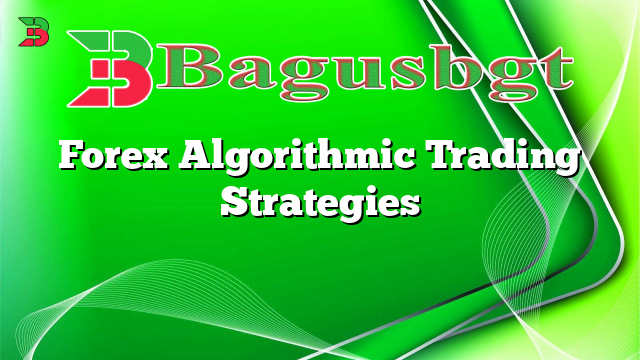Hello readers, welcome to our comprehensive guide on forex algorithmic trading strategies. In this article, we will explore the intricacies of algorithmic trading in the forex market, its advantages and disadvantages, and provide detailed explanations of various strategies. So, let’s dive in!
1. What is Algorithmic Trading?
Algorithmic trading, also known as algo trading or black-box trading, refers to the use of computer programs to execute trading orders in the financial markets. These programs are designed to follow a set of predefined rules and algorithms, enabling them to analyze market data, identify trading opportunities, and execute trades automatically without human intervention.
Algorithmic trading has gained popularity in recent years due to its ability to eliminate human emotions, increase trading speed, and execute orders with precision. It has revolutionized the way traders operate in the forex market, offering numerous benefits and opportunities for both retail and institutional traders.
2. Advantages of Forex Algorithmic Trading Strategies
There are several advantages of using algorithmic trading strategies in the forex market:
| Advantages | Explanation |
|---|---|
| 1. Speed | Algorithmic trading allows for instant order execution, eliminating delays and reducing the impact of market fluctuations. |
| 2. Accuracy | Algorithms can analyze vast amounts of data and make precise trading decisions based on predefined rules, minimizing human errors. |
| 3. Backtesting | Traders can backtest their strategies using historical data to assess their performance before deploying them in live trading. |
| 4. Diversification | Algorithmic trading allows for simultaneous execution of multiple strategies or trades across different currency pairs, reducing risk exposure. |
| 5. Emotional Discipline | By removing human emotions from the trading process, algorithmic trading helps traders stick to their strategies and avoid impulsive decisions. |
3. Disadvantages of Forex Algorithmic Trading Strategies
While algorithmic trading offers numerous advantages, it also has its drawbacks:
| Disadvantages | Explanation |
|---|---|
| 1. Technical Complexity | Developing and maintaining algorithmic trading systems require advanced programming skills and constant monitoring. |
| 2. Reliance on Historical Data | Algorithms are based on historical data, and their performance may vary in different market conditions, leading to potential losses. |
| 3. System Failures | Technical glitches or connectivity issues can disrupt algorithmic trading systems, leading to missed opportunities or losses. |
| 4. Over-Optimization | Excessive tweaking and optimization of algorithms can lead to curve-fitting, where strategies perform well in historical data but fail in live trading. |
| 5. Limited Human Intervention | Algorithmic trading systems lack human judgment and intuition, which can be valuable in certain market conditions or unexpected events. |
4. Common Forex Algorithmic Trading Strategies
There are various algorithmic trading strategies used in the forex market. Let’s explore some of the most common ones:
a) Trend-Following Strategies
Trend-following strategies aim to identify and capitalize on market trends by analyzing price movements and technical indicators. These strategies assume that the trend will continue and seek to enter trades in the direction of the prevailing trend.
Advantages:
- Profit potential in trending markets
- Clear entry and exit signals based on trend indicators
- Reduced reliance on market timing
Disadvantages:
- Whipsaw losses during range-bound or choppy markets
- Delayed entry and exit compared to reversals
- Potential for missed opportunities in fast-moving markets
b) Mean Reversion Strategies
Mean reversion strategies assume that prices will revert to their mean or average value after deviating from it. These strategies identify overbought or oversold conditions and aim to profit from price reversals.
Advantages:
- Profit potential during price reversals
- Clear entry and exit signals based on mean reversion indicators
- Reduced reliance on trend identification
Disadvantages:
- Potential for losses if the mean reversion does not occur
- Delayed entry and exit compared to trending strategies
- Potential for missed opportunities in strong trending markets
c) Breakout Strategies
Breakout strategies aim to capitalize on price breakouts from consolidation or trading ranges. These strategies identify areas of support and resistance and enter trades when prices break above or below these levels.
Advantages:
- Profit potential during volatile market conditions
- Clear entry and exit signals based on breakout indicators
- Reduced reliance on trend or mean reversion
Disadvantages:
- False breakouts leading to losses
- Delayed entry and exit compared to trend or mean reversion strategies
- Potential for missed opportunities during range-bound markets
5. Alternative Approaches to Forex Algorithmic Trading Strategies
While the strategies mentioned above are popular, there are alternative approaches to algorithmic trading in the forex market:
a) High-Frequency Trading
High-frequency trading (HFT) involves executing a large number of trades within milliseconds to exploit small price discrepancies. HFT relies on advanced technology and low-latency trading systems to gain an edge in the market.
b) Statistical Arbitrage
Statistical arbitrage involves identifying and exploiting pricing anomalies or mispricing in correlated securities. These strategies use statistical models to determine the expected relationship between different instruments and profit from temporary deviations.
c) News-Based Trading
News-based trading involves analyzing news releases and economic data to predict market reactions and enter trades based on the news sentiment. These strategies require real-time news feeds and advanced natural language processing techniques.
6. Frequently Asked Questions (FAQ)
Q1. Are algorithmic trading strategies suitable for beginners?
Algorithmic trading strategies require a solid understanding of programming, market dynamics, and risk management. It is recommended for beginners to first gain experience in manual trading before venturing into algorithmic trading.
Q2. How much capital is required for algorithmic trading?
The capital required for algorithmic trading depends on various factors such as the trading strategy, market conditions, and risk tolerance. It is advisable to start with a sufficient capital base to withstand potential losses and cover trading expenses.
Q3. Can algorithmic trading guarantee profits?
No trading strategy, including algorithmic trading, can guarantee profits. The success of algorithmic trading depends on various factors such as market conditions, strategy parameters, and risk management. It is essential to understand the risks involved and use proper risk management techniques.
Q4. How frequently should algorithmic trading strategies be updated?
Algorithmic trading strategies should be regularly monitored and updated to adapt to changing market conditions. It is recommended to backtest and optimize strategies periodically to ensure their effectiveness.
Q5. Are algorithmic trading strategies legal?
Algorithmic trading strategies are legal, provided they comply with regulatory requirements and do not engage in manipulative or illegal activities. Traders should ensure they adhere to applicable laws and regulations in their jurisdiction.
Q6. Can algorithmic trading replace human traders?
While algorithmic trading offers numerous advantages, it cannot completely replace human traders. Human judgment and intuition are still valuable in certain market conditions or unexpected events. Algorithmic trading should be seen as a tool to assist traders rather than a complete replacement.
Q7. How can I get started with algorithmic trading?
To get started with algorithmic trading, you need to acquire the necessary knowledge and skills in programming, market analysis, and risk management. You can also consider using algorithmic trading platforms or working with professional traders or developers to develop and deploy your strategies.
Q8. What are the popular algorithmic trading platforms?
There are several popular algorithmic trading platforms available in the market, catering to both retail and institutional traders. Some of the well-known platforms include:
- MetaTrader: MetaTrader is a widely used trading platform that supports algorithmic trading through its built-in programming language, MQL. It offers a user-friendly interface and a large community of traders and developers.
- NinjaTrader: NinjaTrader is a comprehensive trading platform that provides advanced charting, backtesting, and automation capabilities. It supports multiple programming languages, including C# and NinjaScript.
- TradeStation: TradeStation is a popular platform among professional traders, offering powerful tools for strategy development and optimization. It supports EasyLanguage, a proprietary programming language.
- QuantConnect: QuantConnect is a cloud-based algorithmic trading platform that allows traders to develop and deploy strategies using Python or C#. It provides access to a vast library of pre-built algorithms and data.
Q9. How can I evaluate the performance of algorithmic trading strategies?
The performance of algorithmic trading strategies can be evaluated using various metrics, including:
- Profitability: Measure the overall profitability of the strategy by calculating the return on investment (ROI) or the profit factor.
- Drawdown: Assess the maximum loss experienced by the strategy from its peak value, indicating its risk and potential recovery time.
- Sharpe Ratio: Evaluate the risk-adjusted return of the strategy by comparing the average return to the volatility or risk taken.
- Win Rate: Determine the percentage of winning trades compared to the total number of trades executed by the strategy.
- Risk-Reward Ratio: Analyze the potential reward against the risk taken for each trade, indicating the strategy’s risk management capabilities.
Q10. Are there any risks involved in algorithmic trading?
Yes, algorithmic trading involves certain risks that traders should be aware of. These risks include:
- Technical Risks: System failures, connectivity issues, or data discrepancies can lead to losses or missed opportunities.
- Market Risks: Algorithmic trading strategies are susceptible to market risks, such as price fluctuations, volatility, and unexpected events.
- Execution Risks: The slippage between order placement and execution can impact the strategy’s performance, especially in fast-moving markets.
- Model Risks: Over-optimization, curve-fitting, or incorrect assumptions in the strategy’s model can lead to poor performance in live trading.
- Regulatory Risks: Traders should ensure compliance with applicable laws and regulations to avoid legal issues or penalties.
Conclusion
In conclusion, forex algorithmic trading strategies have revolutionized the way traders operate in the forex market. They offer numerous advantages, such as speed, accuracy, and backtesting capabilities, while also presenting challenges such as technical complexity and reliance on historical data. It is important for traders to understand the various strategies available, evaluate their advantages and disadvantages, and choose the approach that aligns with their trading goals and risk tolerance.
Algorithmic trading is a powerful tool that, when used effectively, can enhance trading performance and efficiency. However, it should be approached with caution and proper risk management to mitigate potential risks. Continuous learning, monitoring, and adaptation are key to success in algorithmic trading. So, equip yourself with the necessary knowledge and skills, explore different strategies, and embark on your algorithmic trading journey with confidence.
 Bagus Banget Kumpulan Informasi terbaru dari berbagai sumber yang terpercaya
Bagus Banget Kumpulan Informasi terbaru dari berbagai sumber yang terpercaya



